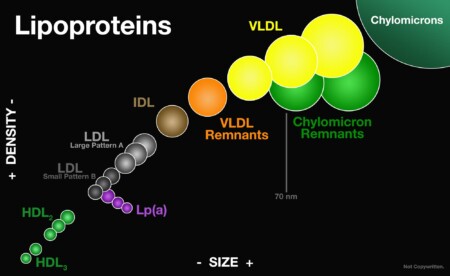About 2 minutes of reading time.
We often hear about LDL being the “bad” cholesterol and HDL being the “good” cholesterol. There are more types based on their sizes and densities. Let’s see where LDL and HDL line up with the others.
NOTE: This page is a supplement to my “managing cholesterol” article in order to keep that one easier to read.
This article provides a VERY CLEAR understanding of lipoproteins, how and where they are made, and their general sizes and functions. It is fairly long, but I encourage you to read it.
Let’s at least understand these GENERALITIES and I will list them in order of size from large to small.
Sizes will be listed in nm and density will be in g/ml.
BTW, there are 1,000,000 nanometers in 1 millimeter, so these particles are VERY tiny.
Chylomicrons
Made in the intestine and transports dietary triglycerides and cholesterol to tissues and the liver.
– Largest in size from 75-1200. Lowest in density of less than .93.
Chylomicron Remnants
Basically Chylomicrons with the removal of triglycerides. Considered pro-atherogenic.
– Size: 30-80 Density: .93-1.006
VLDL (Very Low-Density Lipoproteins)
Produced by the liver and are rich in triglycerides.
– Size: 30-80 Density: .93-1.006 (Not a typo, they can be the same ranges as Chylomicron Remnants.)
IDL/VLDL Remnants (Intermediate-Density Lipoproteins)
Removal of triglycerides from VLDL by muscle and enriched in cholesterol. Considered pro-atherogenic.
– Size: 25-35 Density: 1.006-1.019
LDL (Low-Density Lipoproteins)
Created from VLDL and IDL particles and they are even further enriched in cholesterol. LDL carries the majority of the cholesterol that is in circulation. Not mentioned in the above link, but is worth knowing as referenced here states that LDL moves cholesterol around in the body to where IT IS NEEDED. Yes, LDL plays an important role. More will be discussed about these particles later, but the smaller LDL is considered more pro-atherogenic.
– Size: 18-25 Density: 1.019-1.210
HDL (High-Density Lipoproteins)
These particles are important for returning cholesterol back TO the liver which makes them be considered anti-atherogenic. It is important to note that HDL particles have anti-oxidant and anti-inflammatory properties.
– Size: 5-12 Density: 1.063-1.210
Lipoprotein (a) (Lp (a))
An LDL particle with ApoA attached to it. The physiologic function of this lipoprotein is unknown, but is considered VERY pro-atherogenic. Statins DO NOT lower LP(a) and is pretty much a genetic issue. LP(a) IS included in the LDL measurements so this is one reason I believe not all LDL should be considered as equal.
– Size: ~30 Density: 1.055-1.085 (Between LDL and HDL)
Let’s note that ALL of the lipoproteins above EXCEPT for HDL contain ApoB. HDL is the only lipoprotein that does NOT contain ApoB.
